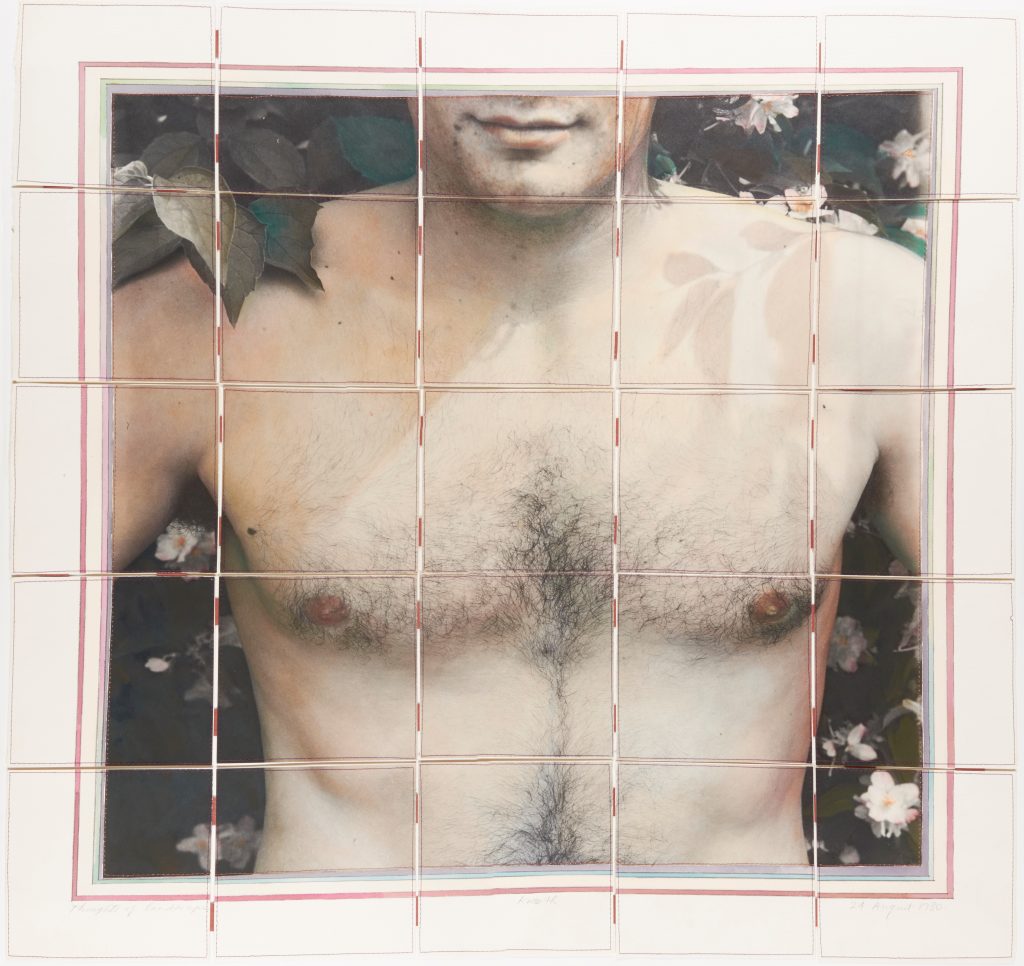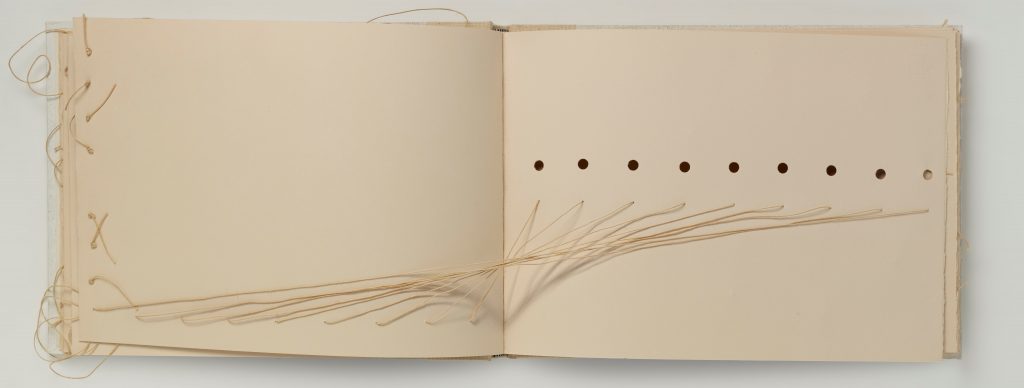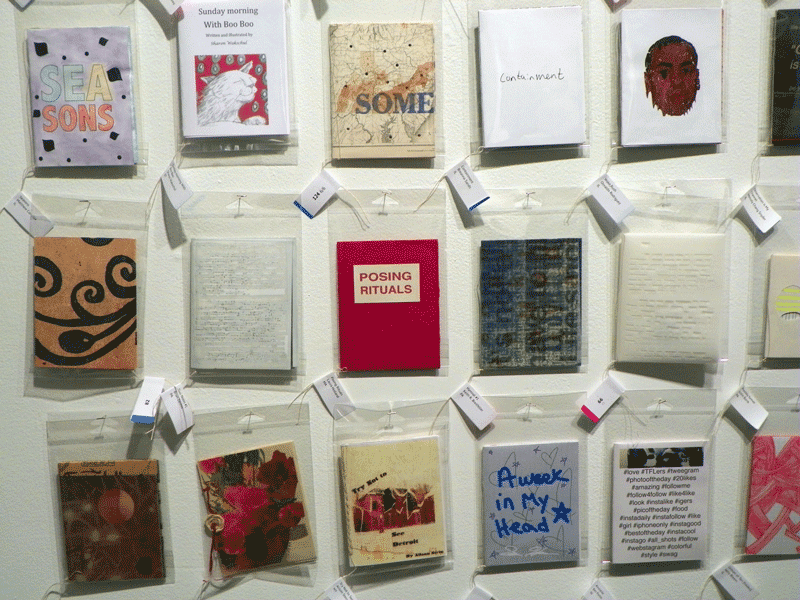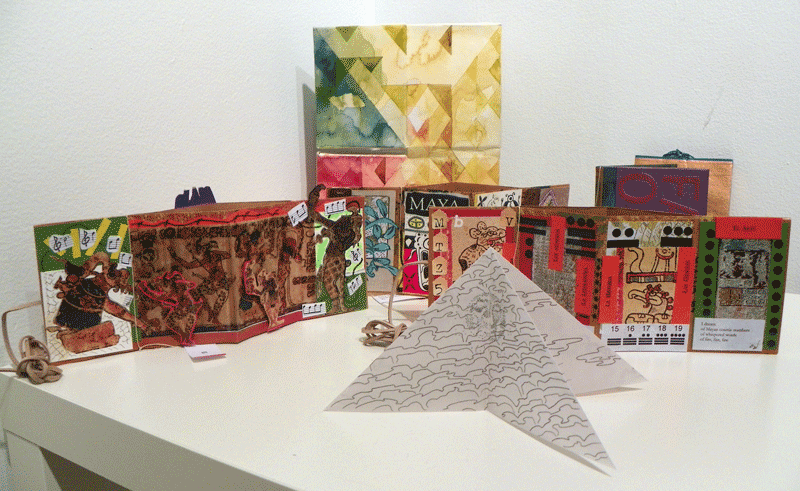 Book Number 141, May 1989, by Keith Smith, American, b. 1938. Snake format artist’s book of gelatin silver prints with colored ink washes, watercolor, and machine stitching. Philadelphia Museum of Art: Purchased with funds contributed by Richard L. and Ronay Menschel, Marion Miller, The Paul & Emily Singer Family Foundation, Peter C. Bunnell, and Trevor Drake and Anne Albright, and with the Lynne and Harold Honickman Fund for Photography, 2015-51-1. © Keith Smith.
Book Number 141, May 1989, by Keith Smith, American, b. 1938. Snake format artist’s book of gelatin silver prints with colored ink washes, watercolor, and machine stitching. Philadelphia Museum of Art: Purchased with funds contributed by Richard L. and Ronay Menschel, Marion Miller, The Paul & Emily Singer Family Foundation, Peter C. Bunnell, and Trevor Drake and Anne Albright, and with the Lynne and Harold Honickman Fund for Photography, 2015-51-1. © Keith Smith.
Keith Smith at Home
February – July 8, 2018
This winter, the Philadelphia Museum of Art presents Keith Smith at Home, the first major monographic presentation of the artist’s work in five decades. Spanning his entire career, the exhibition brings together over 60 exceptional and varied examples of his handmade artist’s books and experimental photographs, prints, collages, and fabric pieces made over the last half century. The exhibition places special emphasis on his artist’s books, the work for which he is best known. Many of these works are from the artist’s collection and have not been exhibited publicly before.
 Margaret Gave me a Rainbow, 2:30pm 21 November, 1971, 1971, by Keith Smith, American, b. 1938. Collage of 3-M Color-in-Color photocopy transferred to buff-colored manila paper, gold star, multicolored thread, gelatin silver print, and rayon braid and tassels, hand and machine stitched to green plain weave cotton with gold rayon faille backing. Courtesy of Bruce Silverstein Gallery, New York. © Keith Smith.
Margaret Gave me a Rainbow, 2:30pm 21 November, 1971, 1971, by Keith Smith, American, b. 1938. Collage of 3-M Color-in-Color photocopy transferred to buff-colored manila paper, gold star, multicolored thread, gelatin silver print, and rayon braid and tassels, hand and machine stitched to green plain weave cotton with gold rayon faille backing. Courtesy of Bruce Silverstein Gallery, New York. © Keith Smith.
Smith is an especially private person, and one whose life at home has been the inspiration for much of his art. Central to the installation is Book Number 82, Keith Smith at Home (1982), showing a sequence of views of his residence in Rochester, New York, where he has lived since 1975. Page by page, it conveys the passage of time: views of the same room shift, household objects trade places, and friends appear and reappear in framed artwork on the house’s walls. Visitors will be able to page through this book digitally on an iPad in the gallery.
 Me at My Shed ‑ About to Go after the Mail, 1973, by Keith Smith, American, b. 1938. Gelatin silver print with colored ink washes, machine stitched to secondary support. Courtesy of Bruce Silverstein Gallery, New York. © Keith Smith.
Me at My Shed ‑ About to Go after the Mail, 1973, by Keith Smith, American, b. 1938. Gelatin silver print with colored ink washes, machine stitched to secondary support. Courtesy of Bruce Silverstein Gallery, New York. © Keith Smith.
The exhibition highlights books that challenge perceptions of what a book can be. Book Number 11, Up (1969) explores the interplay of images by alternating film-positive transparencies with opaque pages. As the film-positive page is turned, it creates the appearance of an image moving from one side of the page to the next. Book Number 91: a string book (1982) consists of cord, punched holes, and blank pages. Strings are extended across each page and spread in different patterns, sometimes taut and other times slack, creating an abstract and rhythmic narrative. Smith considers his string book to be photographic, as it deals with light, shadow, focus, motif, and sequence.
 Book Number 11, Up, 1969, by Keith Smith, American, b. 1938. Artist’s book with photographs, drawings, prints, and transparencies. Courtesy of Bruce Silverstein Gallery, New York. © Keith Smith.
Book Number 11, Up, 1969, by Keith Smith, American, b. 1938. Artist’s book with photographs, drawings, prints, and transparencies. Courtesy of Bruce Silverstein Gallery, New York. © Keith Smith.
Smith has referred to his work as an open diary. Self-representation is a key motif, whether appearing lighthearted or uneasy. Some self-portraits reflect the struggles and joys the artist has experienced in coming out as a gay man, as in Untitled, from Roadside Attractions (1979), a multilayered photograph in which two silhouetted male figures caress each other’s shoulders.
Smith has said, “Social intimidation is not as odious as repression that is self-inflicted. When I permitted my work to speak openly, I gained my freedom and my self-respect.”
 Self Portrait, November 1969, by Keith Smith, American, b. 1938. 3-M Color-in Color-photocopy, hand stitching, and pen and red ink. Courtesy of Keith Smith. © Keith Smith.
Self Portrait, November 1969, by Keith Smith, American, b. 1938. 3-M Color-in Color-photocopy, hand stitching, and pen and red ink. Courtesy of Keith Smith. © Keith Smith.
Also on view is a selection of handmade postcards, a format that Smith has experimented with since the 1960s. He made these cards with particular recipients in mind, but, feeling unable to part with them, has kept them. In addition, the exhibition features fabric pieces from the 1960s and 1970s. Among these is Margaret Gave me a Rainbow 2:30pm 21, November 1971, a collage of a photograph of an ear, curtain tassels, and an impression of the artist’s profile made on a color photocopier affixed to an army-issue bedsheet. Smith made Eye Quilt (1965), a full-size quilt screenprinted with a dense pattern of eyes, while a student at the Art Institute of Chicago.
Keith Smith: Word Play is a related installation on view in the Museum’s Library. This intimate display highlights the ways in which Smith uses word play, poetry, typography, and sequencing to create surprising relationships between images and text in his books.
Exhibition organizer Amanda N. Bock, The Lynne and Harold Honickman Assistant Curator of Photographs, said: “While Smith may seem shy personally, his art is candid, intimate, delightfully irreverent, and transgressive. To share a large body of his work with the public is an exciting and rare opportunity, and it underscores our commitment to showing provocative work by living artists.”
 Aatis with his arm on his hip, August 30, 1973, by Keith Smith, American, b. 1938. Postcard: pen and ink, graphite, and colored ink washes on gelatin silver print, machine stitched to secondary support. Courtesy of Keith Smith. © Keith Smith.
Aatis with his arm on his hip, August 30, 1973, by Keith Smith, American, b. 1938. Postcard: pen and ink, graphite, and colored ink washes on gelatin silver print, machine stitched to secondary support. Courtesy of Keith Smith. © Keith Smith.
About Keith Smith (born 1938, Indiana)
Smith’s reluctance to categorize his work established him as a rogue member of both the photography and printmaking departments at the School of the Art Institute of Chicago, where he graduated in 1967. His works are often radical departures from conventional books, and may unfold, light up, hang on the wall or in a corner, or be constructed of pencils or the shirt off the artist’s own back. Certain themes-friendship, love, desire, intimacy, and domesticity- recur. He has made over 300 artist’s books and over half a dozen seminal instructional manuals on bookbinding.
 Peeled, August 30, 1973, by Keith Smith, American, b. 1938. Postcard: graphite and colored ink washes on gelatin silver print, machine stitched to secondary support. Courtesy of Keith Smith. © Keith Smith.
Peeled, August 30, 1973, by Keith Smith, American, b. 1938. Postcard: graphite and colored ink washes on gelatin silver print, machine stitched to secondary support. Courtesy of Keith Smith. © Keith Smith.
Smith’s work is represented in leading public and private collections, including the Art Institute of Chicago; the Museum of Fine Arts, Houston; the Museum of Modern Art, New York; the San Francisco Museum of Modern Art; the Los Angeles County Museum of Art; the Center for Creative Photography, Tucson; the Nelson-Atkins Museum; the George Eastman Museum, Rochester; the Victoria and Albert Museum, London; and the Philadelphia Museum of Art. He is the recipient of two Guggenheim Fellowships (1972 and 1980) and a National Endowment for the Arts Fellowship (1978), and has taught at the Art Institute of Chicago and the Visual Studies Workshop, Rochester.
 Book Number 91, a string book, 1982, by Keith Smith, American, b. 1938. Artist’s book with cut outs, punched holes, and string. Courtesy of Keith Smith and Philip Zimmermann.
Book Number 91, a string book, 1982, by Keith Smith, American, b. 1938. Artist’s book with cut outs, punched holes, and string. Courtesy of Keith Smith and Philip Zimmermann.
Public Programs
Representing Queerness
Sunday, March 4 | 2:30 p.m. | Perelman Building
Community Conversations open discussions about socially relevant topics.
Included in Pay What You Wish admission.
Bookmaking Workshops
Saturdays, March 17, April 21, and May 5 | 1:30-4:30 p.m. | Perelman Building
Each session includes a tour of Keith Smith at Home with the exhibition curator.
Each workshop: $20 ($16 members); includes Perelman Building admission
Curator
Amanda N. Bock, The Lynne and Harold Honickman Assistant Curator of Photographs
Exhibition Location
Julian Levy Gallery, Ruth and Raymond G. Perelman Building
Installation Location, Library, Second Floor, Ruth and Raymond G. Perelman Building
Support
Support for this exhibition was provided by The Robert Mapplethorpe Foundation.
Social Media
Twitter/Facebook/Instagram/Tumblr/YouTube: @philamuseum
We are Philadelphia’s art museum. A landmark building. A world-renowned collection. A place that welcomes everyone. We bring the arts to life, inspiring visitors-through scholarly study and creative play-to discover the spirit of imagination that lies in everyone. We connect people with the arts in rich and varied ways, making the experience of the Museum surprising, lively, and always memorable. We are committed to inviting visitors to see the world-and themselves-anew through the beauty and expressive power of the arts.
The Philadelphia Museum of Art is located on the Benjamin Franklin Parkway at 26th Street.
Thank you to The Philadelphia Museum of Art for the content of this post.
Like DoNArTNeWs Philadelphia Art News Blog on facebook
Follow DoN on Twitter @DoNNieBeat58
@donniebeat on Instagram
Affiliate Marketing Disclosure Statement
Donate via safe and secure PayPal in the sidebar.
Book 91- String Book; by Keith Smith (1984)












